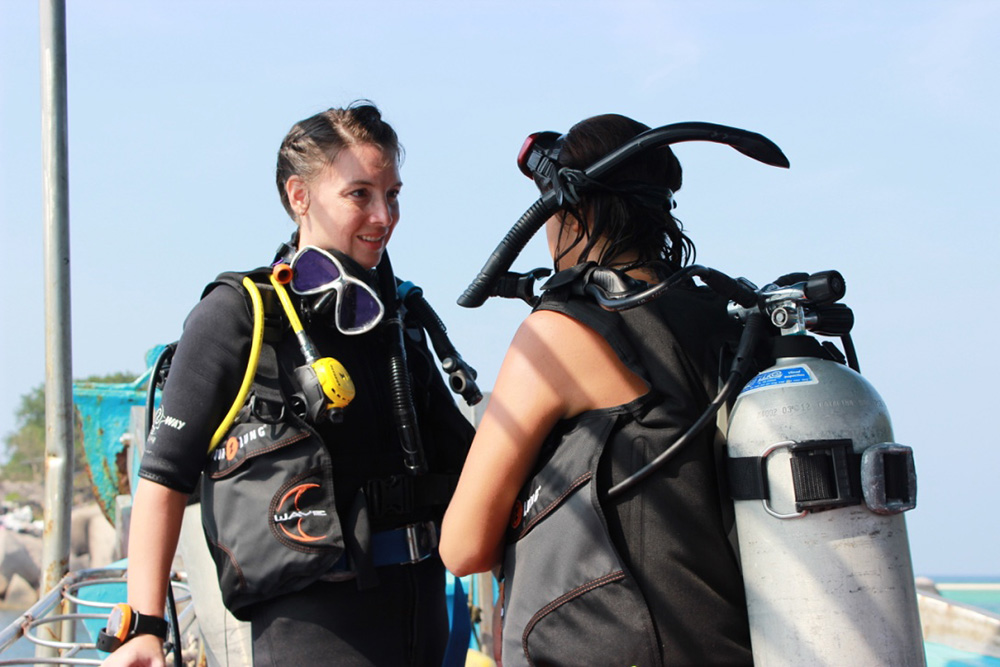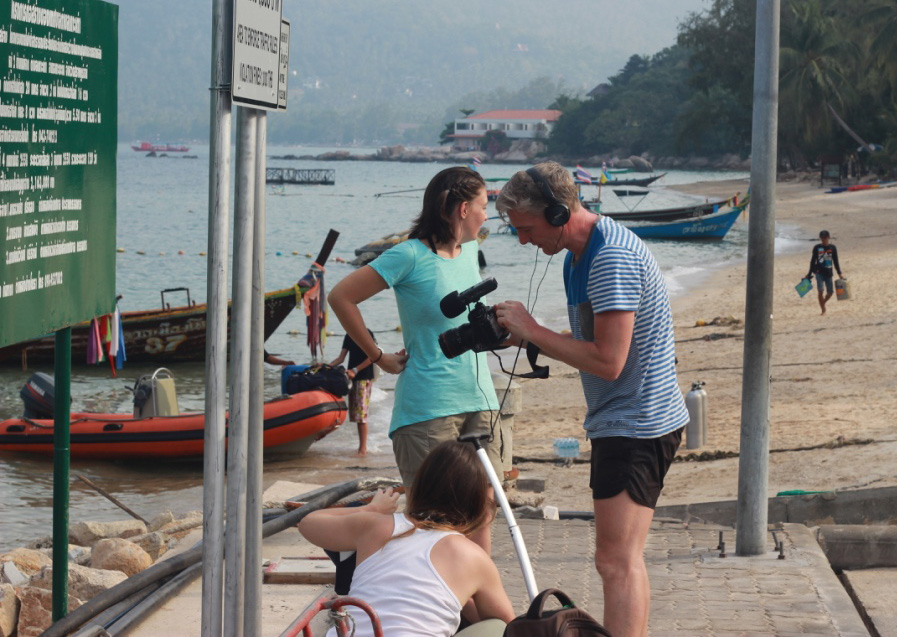Travel + Anxiety

The world lurches, dips, and my stomach goes with it.
It’s too late to back out now. I’m poised to jump, toes dangling over the brink. I close my eyes and hear the Vadarlike hiss of my breathing, feel the tingle of adrenalin in my fingertips. “Just one big step.”
I can sense the unblinking eye of one camera in my peripheral; the bubble lens of another stares up from below. This is supposed to be inspiring, but I’m not really feeling it.
“You’ve got this, Erin. One big step.”
Everyone’s watching, so I take one big step.
And fall.
***
Common wisdom holds you can only die once. Whatever. It’s been fifteen years since I started getting panic attacks, and I know how I’ll react when it’s my time to go: “Ugh, not again.”
Panic attacks are Death Lite: all the symptoms with none of the consequences. Your body reacts exactly as if you were experiencing a traumatic, life-ending event: a car crash, an earthquake, a misguided altercation with a grizzly bear. Adrenaline floods your system and smothers your breathing. Your heart tries to make a break for it as you realize that this is it. You’re actually about to die.
Except you don’t. You return to your senses in the dairy aisle of the grocery store, perfectly safe (though getting weird looks from the other shoppers). Sorry, folks. False alarm. It felt pretty real, though.
It is regrettably easy to classify panic disorder as an imaginary illness. There is nothing to be afraid of, right? It’s all in our heads. Sure, but our heads are liars. They hoodwink our bodies into thinking something is wrong, and we don’t know about it until we’re having the symptoms of sudden-onset death.
Imagine if at unpredictable intervals throughout the day your pants disappeared. It could happen anywhere, at any time. There’s no way to prevent it (though obviously you try). All you know is that at some point in the near future you’re going to feel a breeze in an undesirable location.
Your best chance is to carry a spare pair of slacks and bluff your way through. That’s what most people with panic disorder do—they become stealth ninjas, able to hide themselves (or their symptoms) at will. I was pretty good at it, once upon a time.
Then I spilled to an editor at BBC Travel. A few coincidences later, I was stuffed into a wetsuit on a rocking boat and learning to scuba dive on film.
***
“Spit into your goggles. It keeps them from fogging up.”
I’m bobbing gracelessly on the surface of the Gulf of Thailand. Our boat is tied beside a breaching hunk of grey rock. Apart from that, there’s nothing but blue in every direction, including down.
I hock into my goggles and jam them back over my wet hair. Ignoring the camera, I focus on my instructor through the spit-dribbled lenses.
“Great! Let’s go! ” The air sighs as it leaves his buoyancy vest, and he disappears below the water. I give the boat a last, eloquent look and follow.
***
I became a travel writing junkie at a time in my life when actual travel seemed impossible. So I substituted experiences with stories and got helplessly hooked.
It started innocuously; a friend suggested the book A Walk in the Woods. “Haven’t you read it? You should really try it sometime. It makes me giggle.”
Bill Bryson is a gateway drug. It was a short step from him to Paul Theroux; a nudge further on to Dervla Murphy. Then someone slipped me Tim Cahill, and there was no going back.
Cahill was one of the first travel writers to combine perilous adventure with great prose. His writing is smart, funny, and full of jungles, caves, white water, and speed records. I especially loved his pieces on scuba diving, which he did in various exotic locals, occasionally in the company of great white sharks.
Diving entranced me because I couldn’t even pretend I’d ever have the guts to do it. With or without the sharks.
***
“Did you see those barracuda?” my instructor asks when we surface.
“The what?”
“Barracuda. Three of them. Bigger than you!”
Barracuda look like something out of Jurassic Park, with a prehistoric overbite and a talent for ambush hunting. Think submersible velociraptors.
“You were looking at the angelfish when they came up behind us. Just for a minute. Then they swam off.”
I’m oddly disappointed.
***
It was at a low point that I picked up a collection of Cahill’s essays called Hold the Enlightenment. Near the end of the book, I found a piece titled simply, “Panic.” It described Cahill’s experience with anxiety disorder, juxtaposing a panic attack he had during an interview with the time he nearly took a 3,000 foot plunge while rappelling Yosemite’s El Capitan. In the end, he deemed the interview his bravest moment.
That was my turning point. If an adventurer could have anxiety, then surely I could have adventures. I applied for a job in South Korea, and within months Sam and I had moved to the far side of the world.
My anxiety stopped as soon as I stepped off the plane. Korea shorted out my brain. From that point onward, it forgot to mess with me. Instead, I fell dippily in love with Asia. I became a travel writer.
Then I got cocky.
Since I was cured, I decided it was time to tackle scuba diving. Long story short, it pantsed me. Metaphorically speaking.
There’s no shame in failure. But there is in giving up. I pulled up my pants and contacted BBC Travel.
How’s this for a story idea: traveling with an anxiety disorder. Panic attacks just stopped me from getting my scuba certification. I’m going back to try again. What do you think?
The answer broke my brain again: I think we’ll do a video.
***
It’s our last dive, and our deepest. We follow the rock down. Below the surface, the stone looks like a Tim Burton set. It is crusted in petrified shells, spiney anemones, and pipe cleaner Christmas tree worms. The colors grey as we go down, the blue deepens.
I’ve been shallow diving for three days now. But it’s only here that I fall in love with the sport.
We circle the rock, like astronauts in a sci-fi realm. Yellow-striped butterfly fish drift past us, iridescent parrotfish, dawdling angelfish. We see a plug-ugly puffer and alien-faced batfish. A giant grouper mans a rock archway like a tollbooth. It looks suitably bored.
My instructor pulls me into a school of silver jackfish. They swirl and glitter all around until I lose my bearings. I’m sixty feet below the water, and I forget to be brave or calm or whatever it is I wanted to be on film. I’m just weightless.
***
Roughly 5% of Americans will deal with panic disorder during their lifetime. That’s 16 million people, and every one of them is completely badass. After all, courage has nothing to do with danger—it’s all about fear. Coping with panic disorder requires constant bravery.
Which is why, in the end, I was talked into doing the video. It’s supposed to be inspiring, and I guess it was for me. I’ll be the first to say I am not particularly compelling as a diver or an on-camera personality. But watching it, one thing should be abundantly clear: if some fear-tangled schmo like me can do this, anyone can. All it takes is one big step.
-Erin
So where's this video, then? Right here on BBC Travel's website.






